Mount Auburn Cemetery

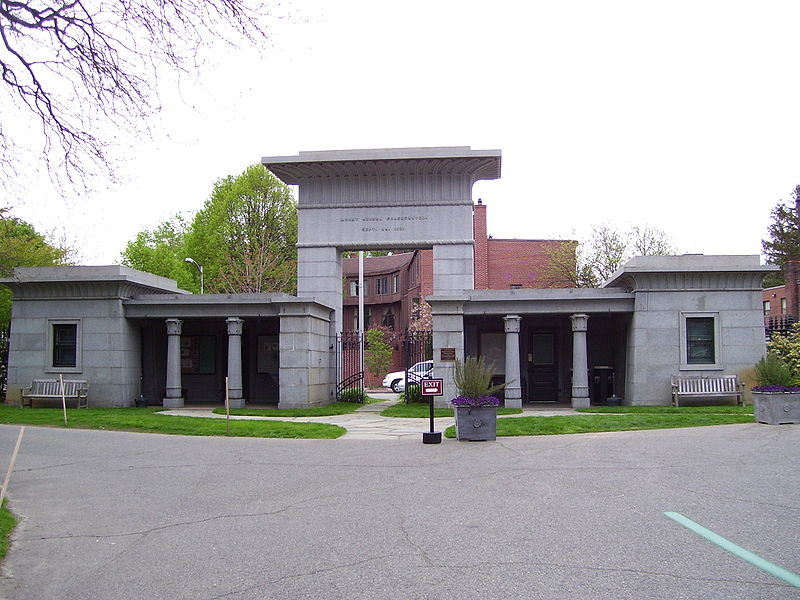
The land that would eventually become Mount
Auburn Cemetery was originally named Stone's Farm, though locals
referred to it as "Sweet Auburn" after the 1770 poem "The Deserted
Village" by Oliver Goldsmith. Mount Auburn Cemetery was inspired by
Père Lachaise cemetery in Paris and was itself an inspiration to
cemetery designers, most notably at Abney Park in London. Mount Auburn
Cemetery was designed largely by Henry Alexander Scammell Dearborn with
assistance from Dr. Jacob Bigelow and Alexander
Wadsworth.
Bigelow
came up with the idea for Mount Auburn as early as 1825, though a site
was not acquired until five years later. Bigelow, a medical doctor, was
concerned about the unhealthiness of burials under churches as well as
the possibility of running out of space. With help from the
Massachusetts Horticultural Society, Mount Auburn Cemetery was founded
on 70 acres (280,000 m2) of land authorized by the Massachusetts
Legislature for use as a garden or rural cemetery. The purchase of the
original land cost $6,000; it later extended to 170 acres (0.69 km2).
The main gate was built in the Egyptian Revival style and cost
$10,000.[above] The first president of the Mount Auburn Association,
Joseph Story, dedicated the cemetery in 1831.
The cemetery is credited as the beginning of
the American public parks and gardens movement. It set the style for
other suburban American cemeteries such as Laurel Hill Cemetery
(Philadelphia, 1836), Mt. Hope Cemetery, America's first municipal
rural cemetery (Rochester, New York, 1838), Green-Wood Cemetery
(Brooklyn, 1838), The Green Mount Cemetery, Baltimore, Maryland 1838,
Albany Rural Cemetery (Menands, New York, 1844) and Forest Hills
Cemetery (Jamaica Plain, 1848) as well as Oakwood Cemetery in Syracuse,
New York. It can be considered the link between Capability Brown's
English landscape gardens and Frederick Law Olmsted's Central Park in
New York (1850s).
<>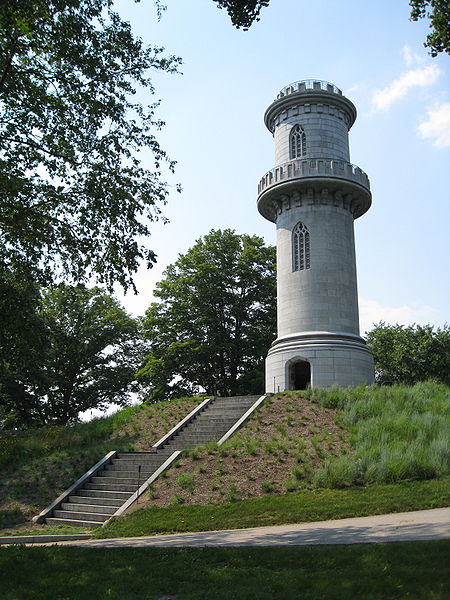 The
main tower in the Cemetery Mount Auburn was established at a
time when Americans had a sentimental interest in rural cemeteries. It
is still well known for its tranquil atmosphere and accepting attitude
toward death. Many of the more traditional monuments feature poppy
flowers, symbols of blissful sleep. In the late 1830s, its first
unofficial guide, Picturesque Pocket Companion and Visitor's Guide
Through Mt. Auburn, was published and featured descriptions of some of
the more interesting monuments as well as a collection of prose and
poetry about death by writers including Nathaniel Hawthorne and Willis
Gaylord Clark. Because of the number of visitors, the cemetery's
developers carefully regulated the grounds: They had a policy to remove
"offensive and improper" monuments and only "proprietors" (i.e., plot
owners) could have vehicles on the grounds and were allowed within the
gates on Sundays and holidays.
The
main tower in the Cemetery Mount Auburn was established at a
time when Americans had a sentimental interest in rural cemeteries. It
is still well known for its tranquil atmosphere and accepting attitude
toward death. Many of the more traditional monuments feature poppy
flowers, symbols of blissful sleep. In the late 1830s, its first
unofficial guide, Picturesque Pocket Companion and Visitor's Guide
Through Mt. Auburn, was published and featured descriptions of some of
the more interesting monuments as well as a collection of prose and
poetry about death by writers including Nathaniel Hawthorne and Willis
Gaylord Clark. Because of the number of visitors, the cemetery's
developers carefully regulated the grounds: They had a policy to remove
"offensive and improper" monuments and only "proprietors" (i.e., plot
owners) could have vehicles on the grounds and were allowed within the
gates on Sundays and holidays.
More than 93,000 people are buried in the cemetery as of
2003. A number of historically significant people have been interred
there since its inception, particularly members of the Boston Brahmins
and the Boston elite associated with Harvard University as well as a
number of prominent Unitarians.
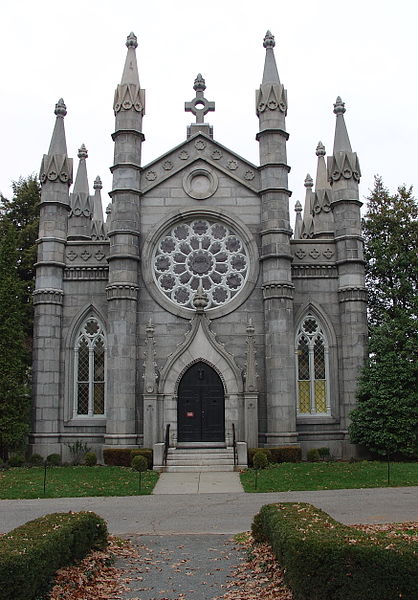
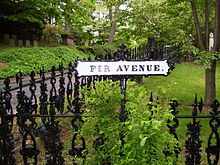
Bigelow Chapel
Signs such as this one for Fir Avenue mark the various lanes in the
cemetery
<>
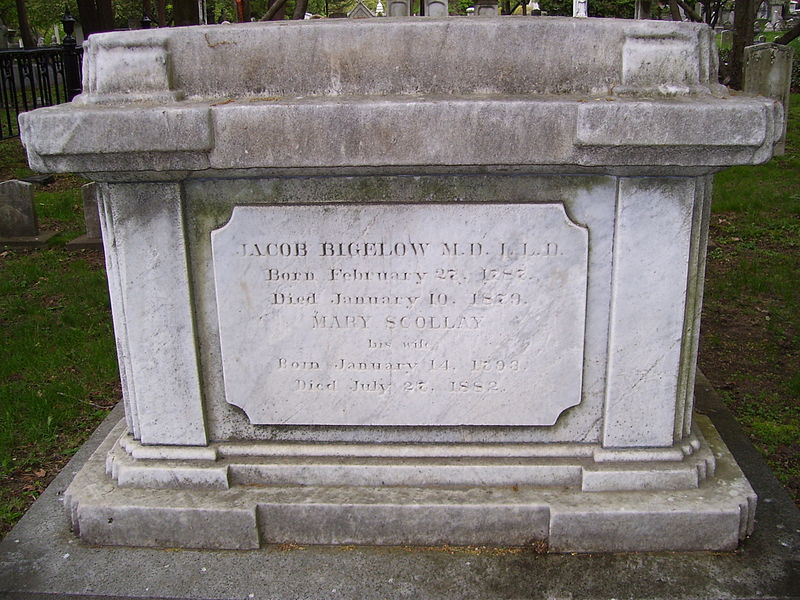 Cemetery designer, Dr. Jacob Bigelow's
grave
Cemetery designer, Dr. Jacob Bigelow's
grave
Mount Auburn's collection of over 5,500 trees
includes nearly 700 species and varieties. Thousands of very well-kept
shrubs and herbaceous plants weave through the cemetery's hills, ponds,
woodlands, and clearings. The cemetery contains more than 10 miles (17
km) of roads and many paths. Landscaping styles range from
Victorian-era plantings to contemporary gardens, from natural woodlands
to formal ornamental gardens, and from sweeping vistas through majestic
trees to small enclosed spaces. Many trees, shrubs, and herbaceous
plants are tagged with botanic labels containing their scientific and
common names.
The cemetery was among those profiled in the
2005 PBS documentary A Cemetery Special.
Also see http://www.mountauburn.org/
Notable burials
Hannah Adams, (1755–1831), author.[10]
Louis Agassiz (1807–1873),[11] scientist
Elizabeth Cary Agassiz (1822–1907), scientist, author
Thomas Bailey Aldrich (1836–1907),[11] author
Nathan Appleton (1779–1861), congressman
William Appleton (1786–1862), congressman
Benjamin E. Bates (1808–1878), industrialist, founder of Bates College
Jacob
Bigelow (1787–1879), designer of Mt. Auburn Cemetery
J.W. Black (1825–1896), photographer
Edwin Booth (1833–1893), actor
Nathaniel Bowditch (1773–1838),mathematician, seaman, author;
his monument was the first life size bronze to
be cast in America
Phillips Brooks (1835–1893), American Episcopal bishop
William Brewster (1851–1919), ornithologist
Charles Bulfinch (1763–1844), architect
McGeorge Bundy (1919–1996), presidential cabinet official
George Cabot (1752–1823), statesman
James Henry Carleton (1814–1873), United States Army officer
William Ellery Channing (1780–1842),[11] Unitarian theologian
John Ciardi (1916–1986), poet, translator
Alvan Clark (1804–1887), astronomer and telescope maker
Robert Creeley (1926–2005), poet
Benjamin Williams Crowninshield (1772–1851), statesman, U.S. Secretary
of the Navy
Frank Crowninshield (1872–1947), creator & editor of "Vanity Fair"
Magazine
Benjamin Robbins Curtis (1809–1874), Supreme Court justice
Charlotte Cushman (1816–1876), actress
Felix Octavius Carr Darley (1821–1888), artist
Samuel Dexter (1761–1816), congressman
Dorothea Dix (1802–1887), nurse, hospital reformer
Mary Baker Eddy (1821–1910),[11] religious leader
Harold "Doc" Edgerton (1903–1990), engineer, scientist
Charles William Eliot (1834–1926), Harvard University president
Edward Everett (1794–1865),[11] Governor of Massachusetts, President of
Harvard University,
United States Secretary of State, speaker at the
Gettysburg Address
William Everett (1839–1910), congressman
Achilles Fang (1910–1995), sinologist, comparatist, and friend of Ezra
Pound
Fannie Farmer (1857–1915), cookbook author
Fanny Fern (1811–1872), feminist author
Annie Adams Fields,[11] author and hostess; wife of James
James Thomas Fields,[11] writer and publisher
Felix Frankfurter (1882–1965), United States Supreme Court Justice
Buckminster Fuller (1895–1983), architect
Isabella Stewart Gardner (1840–1924), art collector, museum founder
Charles Dana Gibson, (1867–1944), illustrator
Curt Gowdy (1919–2006), sportscaster
Asa Gray (1810–1888),[11] 19th century American botanist
Horace Gray (1828–1902), Supreme Court justice
Horatio Greenough (1805–1852), sculptor
Charles Hale (1831–1882), journalist, statesman
Charles Hayden (1870–1937), financier and philanthropist
Oliver Wendell Holmes, Sr. (1809–1894), physician/author[12]
Winslow Homer (1836–1910), artist
Albion P. Howe (1818–1897), Union army general
Julia Ward Howe (1819–1910),[11] activist, poet
Dr. Harriot Kezia Hunt (1805–1875) early female physician -
her monument, a statue of Hygieia, was carved
by Edmonia Lewis.
Harriet Jacobs (1813–1897), escaped slave and author of Incidents in
the Life of a Slave Girl.
Edward F. Jones (1828–1913), NY Lt. Gov. 1886-1891
Edwin H. Land (1909–1991), scientist
Abbott Lawrence (1792–1855), politician, philanthropist
Henry Cabot Lodge (1850–1924), politician
Henry Cabot Lodge, Jr. (1902–1985) politician
Henry Wadsworth Longfellow (1807–1882), poet
A. Lawrence Lowell (1856–1943), Harvard University president
Amy Lowell (1874–1925),[11] poet
Charles Russell Lowell (1835–1864), Civil War General and casualty of
the Battle of Cedar Creek
Francis Cabot Lowell (1855–1911), U.S. Congressman and Federal Judge
James Russell Lowell (1819–1891),[11] poet and foreign diplomat
Josephine Shaw Lowell (1843–1905), Wife of Gen. Charles Russell Lowell,
sister of Col. Robert Gould Shaw
Maria White Lowell (1821–1853), poet and wife of James Russell
Bernard Malamud (1914–1986), writer
Jules Marcou (1824–1898), geologist
William T.G. Morton (1819–1868), demonstrator of ether anesthesia
Stephen P. Mugar (1901–1982), Armenian-American philanthropist and
founder of the Star Market chain of supermarkets
(also the father of David Mugar)
Shahan Natalie (1884–1983), principal organizer of Operation Nemesis,
Armenian national philosophy writer
Charles Eliot Norton (1827–1908), scholar and author
Robert Nozick (1938–2002), philosopher
Richard Olney (1835–1917), statesman
Harrison Gray Otis (1765–1848), U.S. Representative, mayor of Boston
Maribel Vinson-Owen (1911–1961), 9 time U.S. skating champion and coach
Maribel Y. Owen (1940–1961), U.S. pairs figure skating champion
Laurence R. Owen (1944–1961), U.S. ladies skating champion
Harvey D. Parker (1805–1884), hotelier
Francis Parkman,[11] historian
Josiah Quincy III (1772–1864), statesman, educator
John Rawls (1921–2002), philosopher
Charles Sumner's graveAnne Revere (1903–1990), actress
William Eustis Russell (1857–1896), Governor of Massachusetts
Julian Seymour Schwinger, theoretical physicist, Nobel laureate
Lemuel Shaw (1781–1861), Chief Justice of the Massachusetts Supreme
Judicial Court
B.F. Skinner (1904–1990), psychologist
Franklin W. Smith (1826–1911), promoter of historical architecture
Johann Gaspar Spurzheim (1776–1832), phrenologist
Daniel C. Stillson (1830–1899)[1], Inventor of the Stillson pipe wrench
Joseph Story (1779–1845), US Supreme Court Justice
Charles Sumner (1811–1874),[11] statesman
Frank William Taussig (1859–1940), economist
Randall Thompson (1899–1984), composer
William S. Tilton, (1828–1889), Civil War brigade commander
Charles Tufts (1781–1876), businessman who donated the land for Tufts
University
Benjamin Waterhouse (1754–1846), physician
Nathaniel Parker Willis (1806–1867), publisher[13]
Robert Charles Winthrop (1809–1894), statesman
Roger Wolcott (1847–1900), Governor of Massachusetts
Joseph Emerson Worcester,[11] lexicographer
From: Katherine Greenough
I am a direct descendant of Katharine Bigelow
Lawrence (1793 - 1860). Thank you for all your research on the
Bigelow family.
Here are 2 corrections you may want to make to the info. sheet on her.
First, her name is spelled Katharine (note 2 a's), not Katherine, as
was her daughter, Katharine Bigelow Lawrence Lowell.
Second, the Lawrences are buried in MT.
AUBURN CEMETERY in Cambridge, Mass., in a lovely plot surrounded
by a custom made wrought iron fence. Mt. Auburn, founded in 1831,
is a National Historic Landmark, and was the first "garden" cemetery in
the United States. To anyone with an interest in Boston and
Boston family history, it is a treasure trove and to call it "Auburn"
is, well, unfortunate.
See www.mountauburn.org
Undoubtedly, numerous Boston area Bigelows are
buried in Mt. Auburn. I do hope you can make these corrections,
and do visit Mt. Auburn when you come to Boston.
Thank you.
Katherine Lawrence Greenough
Boston, Mass.
PS
I thought you'd like to know that Mt. Auburn Cemetery was founded by a
Dr. Jacob Bigelow. He designed the magnificent Egyptian style
entrance and, working with the architect Gridley Bryant, the Gothic
Bigelow Chapel on the grounds of the cemetery.
Katherine Greenough
From: Quinn, Maureen R. <
Maureen.Quinn@gd-ais.com >
Subject: Bigelow and Mount Auburn
Cemetery
CC: "Maureen Quinn" < mrmquinn@verizon.net >
Date: Thursday, September 1, 2011, 9:27 AM
I am a licensed battlefield guide at Gettysburg and when I have
visitors with me from Massachusetts, I like to tell them about Capt
Bigelow and his actions during the battle.
However, my reason for writing you is not John Bigelow but the man who
founded Mount Auburn Cemetery, Dr.
Jacob Bigelow. Is he related to Capt Bigelow? Only very distant as can be seen from web
pages.......................Rod 2011
Thank you for whatever info you can give me.
Maureen Reigh Quinn
GD-AIS/ISED
 Rod Bigelow
Box 13 Chazy Lake
Rod Bigelow
Box 13 Chazy Lake
Dannemora, N.Y. 12929
 rodbigelow@netzero.net
rodbigelow@netzero.net  Back
to Bigelow Society
Back
to Bigelow Society

BACK TO BIGELOW
HOME PAGE


 The
main tower in the Cemetery Mount Auburn was established at a
time when Americans had a sentimental interest in rural cemeteries. It
is still well known for its tranquil atmosphere and accepting attitude
toward death. Many of the more traditional monuments feature poppy
flowers, symbols of blissful sleep. In the late 1830s, its first
unofficial guide, Picturesque Pocket Companion and Visitor's Guide
Through Mt. Auburn, was published and featured descriptions of some of
the more interesting monuments as well as a collection of prose and
poetry about death by writers including Nathaniel Hawthorne and Willis
Gaylord Clark. Because of the number of visitors, the cemetery's
developers carefully regulated the grounds: They had a policy to remove
"offensive and improper" monuments and only "proprietors" (i.e., plot
owners) could have vehicles on the grounds and were allowed within the
gates on Sundays and holidays.
The
main tower in the Cemetery Mount Auburn was established at a
time when Americans had a sentimental interest in rural cemeteries. It
is still well known for its tranquil atmosphere and accepting attitude
toward death. Many of the more traditional monuments feature poppy
flowers, symbols of blissful sleep. In the late 1830s, its first
unofficial guide, Picturesque Pocket Companion and Visitor's Guide
Through Mt. Auburn, was published and featured descriptions of some of
the more interesting monuments as well as a collection of prose and
poetry about death by writers including Nathaniel Hawthorne and Willis
Gaylord Clark. Because of the number of visitors, the cemetery's
developers carefully regulated the grounds: They had a policy to remove
"offensive and improper" monuments and only "proprietors" (i.e., plot
owners) could have vehicles on the grounds and were allowed within the
gates on Sundays and holidays.



